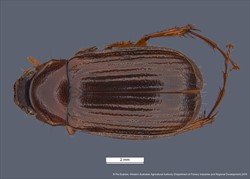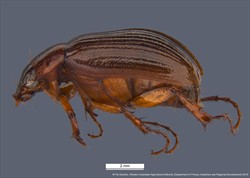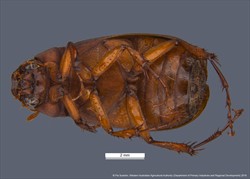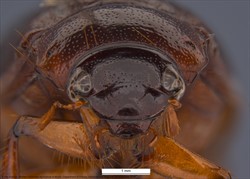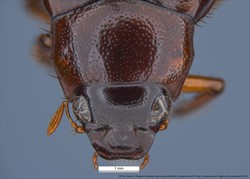Sub family: Melolonthinae / Tribe: Sericini / Genus: Serica
Fact Sheet
Serica MacLeay 1819
Small, oblong to ovate beetles, body length 5-11mm. Body colouration yellowish brown, reddish brown to blackish and often with an irridescent sheen. Antennae with 8-9 segments, and a 3-segmented club. Labrum attached to apical margin of clypeus, separated by a suture. Highly variable clypeal apex shape, varying between rounded, emarginate, subquadrate or truncate. Frontoclypeal suture distinct, variable in shape. Regularly spaced striation on the elytra present. Metacoxae greatly enlarged. Penultimate ventrite and propygidium separated by a suture. Metatibial apical spurs separated, so that tarsi can move between them.
Little information is known about the biology of most species. Adult beetles are leaf feeders, most commonly on deciduous trees. Most species are nocturnal and attracted to lights, though diurnal species also exist. Larvae are root feeders.
The genus is widespread, with representatives found in the Palearctic, Nearctic, Oriental, and Ethiopian regions. It is absent from Australia.
Britton, E.B. 1957. A Revision of the Australian Chafers (Coleoptera: Scarabaeidae: Melolonthinae). London : British Museum Vol. 1 vii 185 pp.
Ratcliffe, B.C., Jameson, M.L., Smith, A.B.T. . 2002. Chapter 34. Scarabaeidae Latreille1802, pp. 39–81 (in part). In: Arnett, R. H., M. C. Thomas, P. E. Skelley, and J. H. Frank (eds.), American Beetles, Volume 2. CRC Press, Boca Raton, FL. 861 pp.
Ratcliffe, B.C., Paulsen, M.J. 2008. The Scarab Beetles of Nebraska. Bulletin of the University of Nebraska, Vol. 22. 570pp.

